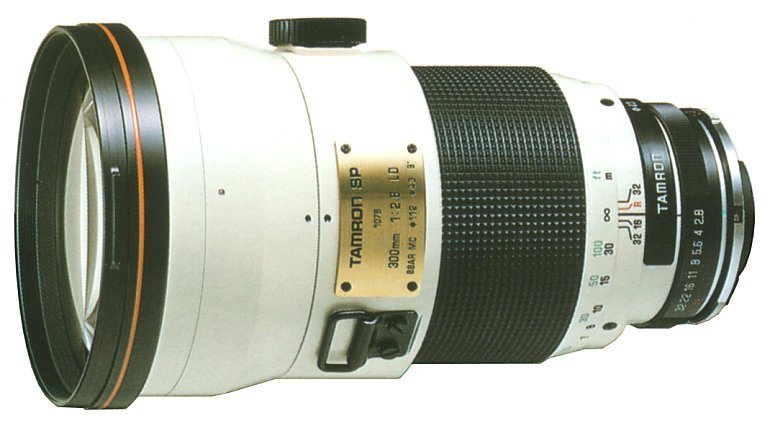|
Tamron SP 300mm F/2.8 LD (non-IF) Model 107B: The Model
107B is the original version of Tamron's SP 300 F/2.8 which was introduced in
1983. It was beautiful, expensive and is very rare since so very few were made
during its one year production run. It does not feature the internal focus (IF)
found in the later versions of this lens, but features very robust
construction and is slightly heavier. This rare lens was finished in gloss
white, is a very good lens for low light telephoto work, and is highly sought
after as a collector's item. Two low dispersion (LD) elements are used in this
lens, which I am pretty sure are the first (front) and the third element in the
above optical layout. This lens also features a spherical aberration
compensator group (the cemented doublet in the middle of the lens) which
assures crisp images even at close focus distances.
 Tamron unveiled a prototype of this
lens (shown at right) at PMA 1982. The 107B prototype was finished in
semi-gloss black, featured a built-in lens hood and a minimum aperture of F/22,
and featured Tamron's scribed rubber focus grip rather than the diamond
textured focus grip found on the production models. Notably, the prototype lens
didn't feature a tripod socket. Tamron's representatives at PMA '82 described
this lens as being designed to be "hand-held" rather than correctly explaining
that the lens was merely a prototype! Tamron unveiled a prototype of this
lens (shown at right) at PMA 1982. The 107B prototype was finished in
semi-gloss black, featured a built-in lens hood and a minimum aperture of F/22,
and featured Tamron's scribed rubber focus grip rather than the diamond
textured focus grip found on the production models. Notably, the prototype lens
didn't feature a tripod socket. Tamron's representatives at PMA '82 described
this lens as being designed to be "hand-held" rather than correctly explaining
that the lens was merely a prototype!
Optically, the model 107B has slight inherent softness caused by
very slight overcorrected spherical aberration which is introduced when using a
rear drop-in standard filter. The extremely slight softness (when using the
standard drop-in filter) makes this lens especially suitable for close-up
portrait and stage photography whenever you don't want the finest of details
rendered absolutely razor sharp. Removing the filter from the lens's rear
filter holder makes the very slight spherical aberration disappear. The result
is a significant increase in contrast and sharpness. Oops!!! Tamron's optical
engineers originally designed this lens without accounting for the optical
effects of the rear drop-in rear filter within the very fast F/2.8 optical
path. The rear drop-in filter was added later during development after the
initial optical design had already been "carved in stone". Remove the filter
from the rear filter holder, and this gorgeous yet extremely rare lens will
perform nearly as well as the model 60B introduced the following year. The
later model 60B is somewhat sharper towards the corners and was designed to
always be used with a filter in the rear filter slot. You can get the
same slight softness effect with the later model 60B simply by removing the
rear drop-in filter. The result will be slight undercorrected spherical
aberration. The rear filter removal for this lens isn't merely a theory; I
verified the results by testing my SP 300mm model 107B on my optical bench with
50x magnification at the focal plane. Shown further below are Modern
Photography's test results with the filter along with my test results without
the filter.
Lens Specifications:
| Lens Model |
107B |
| Focal Length |
300mm |
| Aperture Range |
f/2.8 — 32, AE |
| Angle of View |
8° |
Optical
Construction
(Groups / Elements) |
6 / 7 |
| Min. Focus from Film
Plane |
118" (3.0m) |
| Macro Mag. Ratio [w/2X
Converter] |
— |
| Filter Size |
43mm (rear), 112mm (front) |
| Diameter |
4.6" (117.5mm) |
Length at

[w/Nikon mount] |
7.8" (199mm)
[8.0" (203.5mm)] |
| Weight |
73 oz. (2071g) |
| Lens Hood |
Bayonet type #38FH, reversible. |
| Accessory |
Accepts SP 2X tele-converter #01F. Supplied
wth lens hood. Additional 43mm rear filters and 112mm front filter available as
optional extras. |
|



